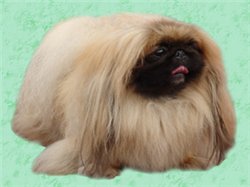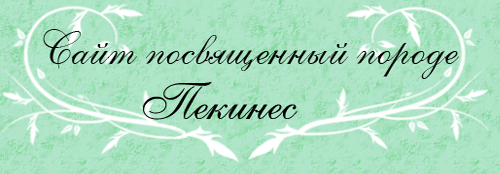Pekingese Breed Standard
Revised Standard for the Pekingese
The Board of Directors of The American Kennel Club has approved the following revised standard for the Pekingese as submitted by the Pekingese Club of America, Inc. General Appearance
The Pekingese is a well-balanced, compact dog with heavy front and lighter hindquarters. It must suggest its Chinese origin in its directness, independence, individuality and expression. Its image is lionlike. It should imply courage, boldness and self-esteem rather than prettiness, daintiness or delicacy.
Size, Substance, Proportion
Size/Substance
The Pekingese should be surprisingly heavy when lifted. It has a stocky, muscular body. The bone of the forequarters must be very heavy in relation to the size of the dog. All weights are correct within the limit of 14 pounds, provided that type and points are not sacrificed. Disqualification: weight over 14 pounds.
Proportion
The length of the body, from the front of the breast bone in a straight line to the buttocks, is slightly greater than the height at the withers. Overall balance is of utmost importance.
Head
Skull
The topskull is massive, broad and flat (not dome-shaped). The topskull, the high, wide cheek bones, broad lower jaw and wide chin are the structural formation of the correctly shaped face. When viewed frontally, the skull is wider than deep and contributes to the rectangular envelope-shaped appearance of the head. In profile, the Pekingese face must be flat. The chin, nose leather and brow all lie in one plane. In the natural position of the head, this plane appears vertical but slants very slightly backward from chin to forehead.
Nose
It is black, broad, very short and in profile, contributes to the flat appearance of the face. Nostrils are open. The nose is positioned between the eyes so that a line drawn horizontally across the top of the nose intersects the center of the eyes.
Eyes
They are large, very dark, round, lustrous and set wide apart. The look is bold, not bulging. The eye rims are black and the white of the eye does not show when the dog is looking straight ahead.
Wrinkle
It effectively separates the upper and lower areas of the face. The appearance is of a hair covered fold of skin, extending from one cheek, over the bridge of the nose in a wide inverted "V", to the other cheek. It is NEVER so prominent or heavy as to crowd the facial features nor to obscure a large portion of the eyes or the nose from view.
Stop
It is deep. The bridge of the nose is completely obscured from view by hair and/or the over-nose wrinkle.
Muzzle
This is very short and broad with high, wide cheek bones. The color of the skin is black. Whiskers add to the Oriental expression.
Mouth
The lower jaw is slightly undershot. The lips meet on a level plane and neither teeth nor tongue show when the mouth is closed. The lower jaw is strong, wide, firm and straight across at the chin. An excessively strong chin is as undesirable as a weak one.
Ears
They are heart-shaped and set on the front corners of the skull extending the line of the topskull. Correctly placed ears frame the sides of the face and with their heavy feathering create an illusion of additional width of the head.
Pigment
The skin of the nose, lips and eye rims is black on all colors.
Neck, Body, Tail
Neck
It is very short, thick and set back into the shoulder.
Body
This is pear-shaped and compact. It is heavy in front with well-sprung ribs slung between the forelegs. The broad chest, with little or no protruding breast bone, tapers to lighter loins with a distinct waist. The topline is level.
Tail
The base is set high; the remainder is carried well over the center of the back. Long, profuse straight feathering may fall to either side.
Forequarters
They are short, thick and heavy-boned. The bones of the forelegs are slightly bowed between the pastern and elbow. Shoulders are gently laid back and fit smoothly into the body. The elbows are always close to the body. Front feet are large, flat and turned slightly out. The dog must stand well up on feet.
Hindquarters
They are lighter in bone than the forequarters. There is moderate angulation and definition of stifle and hock. When viewed from behind, the rear legs are reasonably close and parallel and the feet point straight ahead. Soundness is essential in both forequarters and hindquarters.











